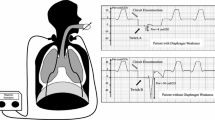Summary
In malignant hyperthermia (MH), volatile anesthetics and depolarizing muscle relaxants, i.e., succinylcholine, induce a potentially lethal hypermetabolic syndrome of skeletal muscle. Uncontrolled sarcoplasmic Ca2+ release via the ryanodine receptor (RYR1) activates actin-myosin filaments leading to contracture, and triggers mitochondrial energy turnover with a massive increase in oxygen consumption, and carbon dioxide and heat production. Most prominent clinical signs of a MH crisis are tachycardia, masseterspasm or rigor, hypercapnia, metabolic-respiratory acidosis, flush followed by hypoxia and cyanosis, hypotension, arrhythmias, increase in body temperature, hyperkalemia and rhabdomyolysis. Abortive cases with only few clinical signs, such as metabolic acidosis and postoperative rhabdomyolysis, are much more frequent. Immediate therapy of MH is mandatory. Cessation of triggering agents, increased ventilation and oxygenation with 100% O2, and intravenous infusion of dantrolene, an inhibitor of sarcoplasmic Ca2+ efflux, is the basis of causative therapy. Symptomatic treatment includes trigger-free anesthesia, treatment of acidosis, fluid and electrolyte replacement, cooling, as well as prevention of organ failure such as arrhythmia, renal failure, cerebral edema and disseminated coagulopathy. Increased hemodynamic and metabolic monitoring in an intensive care unit, e.g., by arterial and central venous line, by blood gases, CK and electrolytes, is useful. With adequate therapy, complete recovery is warranted. These patients should be transferred to a MH specialist to confirm susceptibility to MH by the in vitro contracture test with caffeine and halothane with a sensitivity of >99% and a specificity of 94%. More than 30 different MH-associated mutations have been identified in the gene of the ryanodine receptor allowing for the detection of the causative genetic defect in 20–40% of MH individuals. However, a genetic test can replace the invasive in vitro contracture test only in families with a known RYR1 mutation. New diagnostic strategies aim on provocative metabolic testing in vivo, in myoblast cultures and in lymphocytes.
Zusammenfassung
Die maligne Hyperthermie, ein potentiell lebensbedrohliches hypermetaboles Syndrom der Skelettmuskulatur, wird durch volatile Inhalationsanästhetika und depolarisierende Muskelrelaxantien ausgelöst. Eine unkontrollierte sarkoplasmatische Ca2+-Freisetzung über den Ryanodin-Rezeptor (RYR1) aktiviert die kontraktilen Filamente mit dem klinischen Bild des Rigors, und steigert den mitochondrialen Energieumsatz mit exzessiver Erhöhung des Sauerstoff-Verbrauchs und der Kohlendioxid-Produktion. Die augenfälligsten klinischen Zeichen sind Tachykardie, Rigor oder Masseterspasmus, Hyperkapnie, metabolisch-respiratorische Azidose und Rötung der Haut gefolgt von Hypoxie und Zyanose, Hypotension, kardialen Arrhythmien, Temperaturanstieg, Hyperkaliämie und Rhabdomyolyse. Abortive Verlaufsformen sind häufig. Bereits bei Verdacht ist eine sofortige Therapie indiziert. Die kausale Therapie beinhaltet das Absetzen des Triggers, gesteigerte Ventilation und Oxigenierung mit 100% O2, und intravenöse Infusion von Dantrolen, einem Inhibitor der sarkoplasmatischen Ca2+-Freisetzung. Zur symptomatischen Therapie zählen die Gabe trigger-freier Anästhetika, die Behandlung von Azidose, Volumen- und Elektrolytstörungen sowie die Prophylaxe sekundärer Organschädigungen wie Nierenversagen oder disseminierter Koagulopathie unter intensivmedizinischer Überwachung. Patienten mit MH-Verdacht sollten an ein MH-Labor zur weiteren Betreuung und Diagnostik mittels In-vitro-Kontrakturtest und genetischer Diagnostik überwiesen werden.
Similar content being viewed by others
Author information
Authors and Affiliations
Additional information
Eingegangen: 17. Oktober 2002 Akzeptiert: 21. Dezember 2002
Serie: Die Intensivtherapie bei neuromuskulären Erkrankungen Herausgegeben von E. Hund (Heidelberg) und W. Müllges (Würzburg)
Correspondence to Martin Anetseder
Rights and permissions
About this article
Cite this article
Anetseder, M., Müller, C. Maligne Hyperthermie. Intensivmed 40, 324–335 (2003). https://doi.org/10.1007/s00390-003-0371-6
Issue Date:
DOI: https://doi.org/10.1007/s00390-003-0371-6




